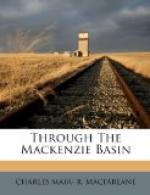The Quatre Fourches—“The Four Forks”—gets its name from the junction of a channel which connects a small lake called the Mamawee with the south-west angle of Lake Athabasca, Fort Chipewyan being situated on an opposite shore upon an arm of the lake, here about six miles wide. The stream is sluggish, and is thickly wooded to the water’s edge, with here and there an exposure of red granite. It is a very beautiful stream, and it was a pleasure to get out of the great river and its oppressive vastness into the familiar-looking, homely water, its eastern rocks and exquisite curves and bends. Rounding a point, we came upon a camp of Chipewyans drying fish and making birch-bark canoes, all of them fat, dirty, like ourselves, and happy; and, passing on, at dusk we reached the outlet and the lake.
It was blowing hard, but we decided to cross to the fort, where a light had been run up for our guidance, and which, by vigorous rowing, we reached by midnight. Here Mr. Laird was waiting to receive us, the other Commissioners having departed for Fort McMurray and Wahpooskow.
Next morning we saw the lake to better advantage. It is called by the Chipewyans Kaytaylaytooway, namely, “The Lake of the Marsh,” corresponding to the Athapuskow of the Crees, corrupted into the Rabasca of the French voyageurs, and meaning “The Lake of the Reeds.” At one time, it may be mentioned, it was also known as “The Lake of the Hills,” and its great tributary, the Athabasca, was the Elk River; but these names have not survived.
Chapter VIII
Fort Chipewyan To Fort McMurray.
Chipewyan, it may be remarked, is not a Dene word. It is the name which was given by the Crees to that branch of the race when they first came in contact with them, owing to their wearing a peculiar coat, or tunic, which was pointed both before and behind; now disused by them, but still worn by the Esquimaux, and, until recent years, by the Yukon Indians. Though somewhat similar in sound, it has no connection, it is asserted, with the word Chippeway, or Ojibway. For all that, the words are perhaps closely akin. The writer for the accurate use in this narrative of words in the Cree tongue is under obligation to experts. When preparing his notes to his drama of “Tecumseh” he was indebted to his friend, Mr. Thomas McKay, of Prince Albert, Sask., a master of the Cree language, for the exact origin and derivation of the words Chippeway and Ojibway. Both are corruptions of O-cheepo-way, cheepo meaning “tapering,” and way “sound,” or “voice.” The name was begot of the Ojibway’s peculiar manner of lowering the voice at the end of a sentence. As “wyan” means a skin, it is not improbable that the word Chipewyan means tapering or “pointed” skin, referring, of course, to the peculiar garb of the Athapuskow Indians when the Crees first met with them.




